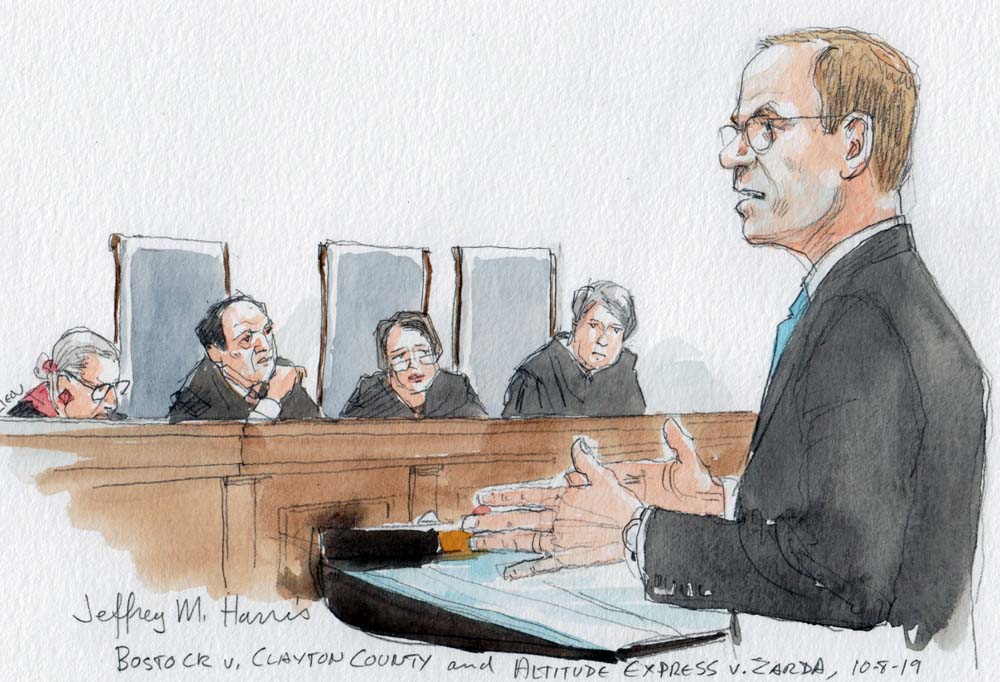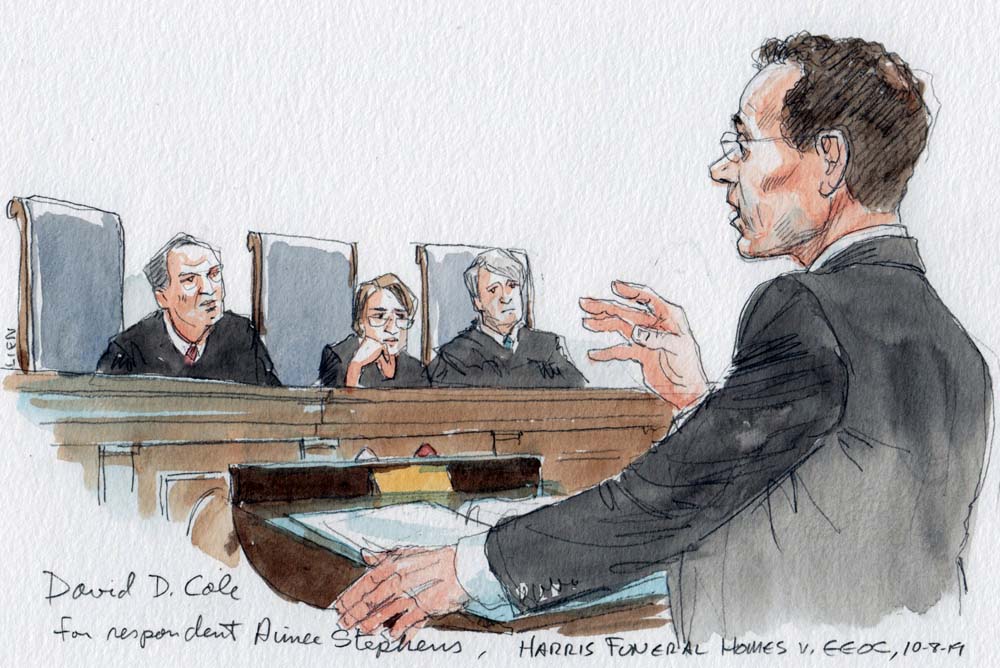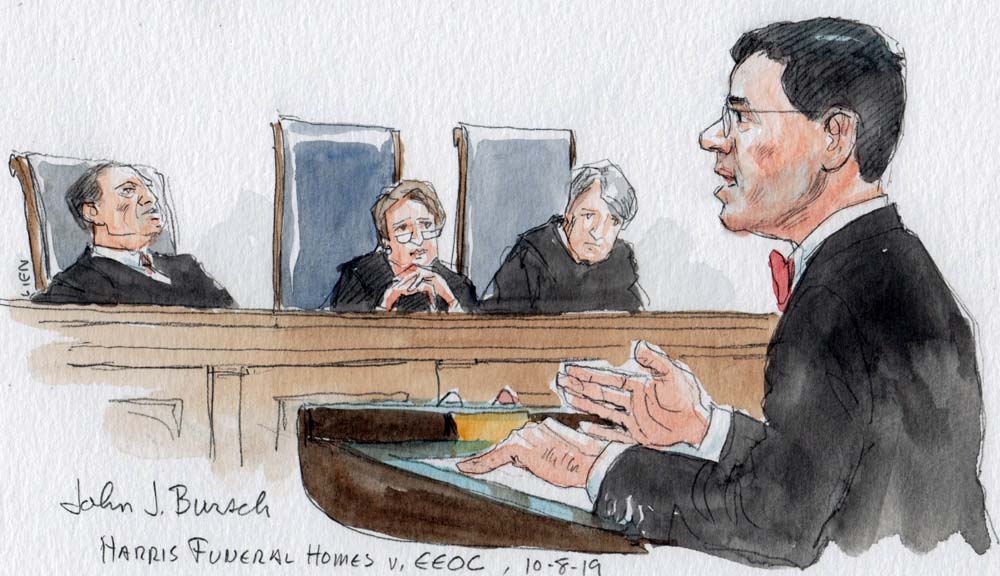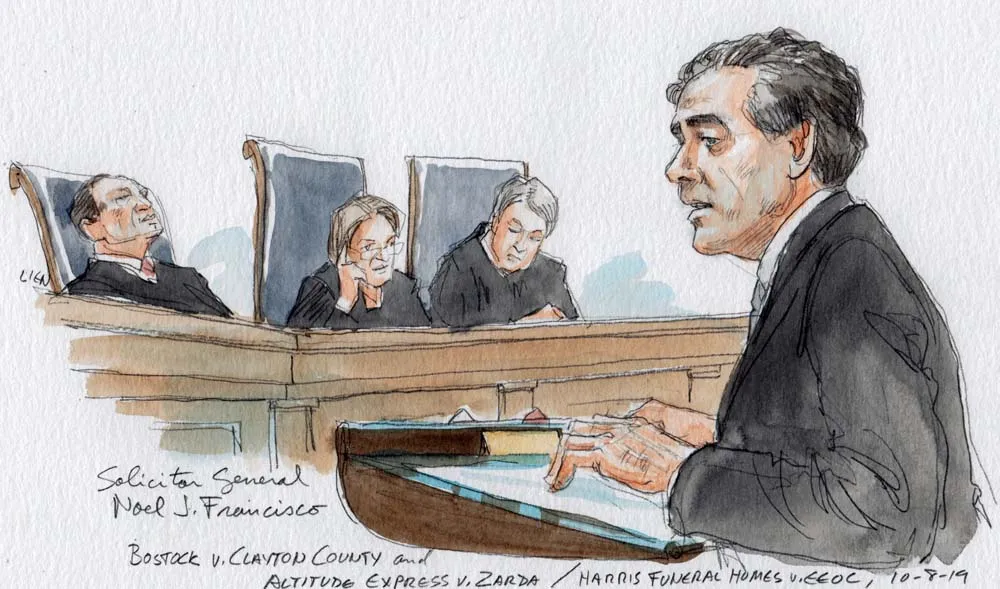Argument analysis: Justices divided on federal protections for LGBT employees (UPDATED)

on Oct 8, 2019 at 2:14 pm
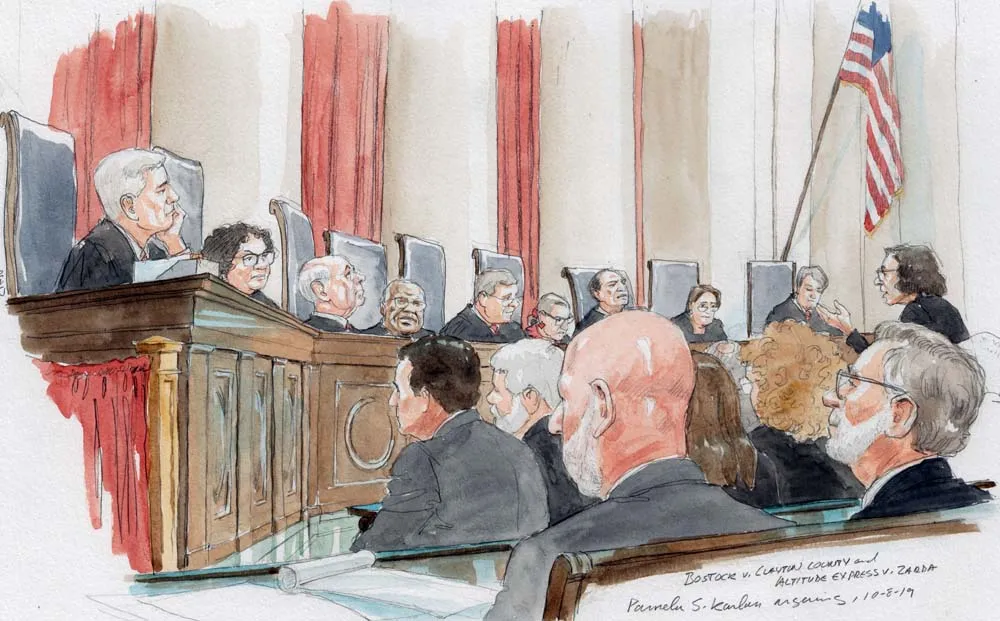
Editor’s note: This post has been updated to include discussions of exchanges between Chief Justice John Roberts and advocate Pamela Karlan in Bostock v. Clayton County, and between Justices Neil Gorsuch and Samuel Alito and advocate David Cole in Harris Funeral Homes v. EEOC.
Title VII of the Civil Rights Act of 1964 bars employment discrimination “because of … sex.” This morning, in a packed courtroom, the Supreme Court heard oral argument on whether Title VII protects gay, lesbian and transgender employees. Because fewer than half of the 50 states specifically bar discrimination based on sexual orientation or gender identity, the court’s ruling could be significant. And after over two hours of debate, it was not clear how the justices are likely to rule. The outcome of the two cases could hinge on Justice Neil Gorsuch, who at times appeared sympathetic to the plaintiffs’ argument but also expressed concern about the “massive social upheaval” that he believed would follow from a ruling for them.
The morning was divided into two arguments, involving closely related – but not identical – issues: a pair of cases, argued together, involving whether Title VII bans discrimination based on sexual orientation, followed by a third case in which the justices are considering whether the law prohibits discrimination based on transgender status.
First up this morning was Stanford law professor Pamela Karlan, arguing on behalf of two men who contend that they were fired from their jobs because they were gay. Donald Zarda (who died in 2014 in a base-jumping accident in Switzerland) had been working as an instructor for a skydiving company now known as Altitude Express, while Gerald Bostock had worked as a child-welfare-services coordinator in Clayton County, Georgia.
Karlan spent much of her time at the lectern dealing with two main sets of concerns. The first was the argument that Congress could not possibly have intended to bar employment discrimination based on sexual orientation when it passed Title VII back in 1964. After all, Justice Ruth Bader Ginsburg observed, at that time the American Psychiatric Association labeled homosexuality a mental illness.
Karlan countered that the Supreme Court has recognized other claims that Congress could not have contemplated when it enacted Title VII. 1964, Karlan noted, was the era of the television show “Mad Men”: Congress would not have recognized sexual harassment as covered by Title VII, but courts nonetheless recognize it now.
Instead, Karlan reiterated, the justices should focus on the text of Title VII. When Chief Justice John Roberts asked her to comment on a statement by now-retired Judge Richard Posner of the U.S. Court of Appeals for the 7th Circuit, who said that Title VII should be read to include discrimination based on sexual orientation to “avoid placing the entire burden of updating old statutes on the legislative branch,” Karlan argued that no updating is required. Reading the words of Title VII “as they were understood then, which is ‘men’ and ‘women,’ Title VII was intended to make sure that men were not disadvantaged relative to women and women were not disadvantaged relative to men.”
Karlan also fielded questions from the justices about the broader implications of a ruling in favor of the plaintiffs – particularly for issues like same-sex bathrooms and dress codes. Karlan suggested that the bathroom issue is a straw man, because Title VII specifically addresses the situation and indicates that the central question is whether providing same-sex bathrooms denies someone an employment opportunity. “And it is hard to see, quite honestly, how requiring men to use a men’s room and women to use a women’s room denies them employment opportunities,” Karlan stressed. And the dress-code issue, Karlan continued, is one that the justices will have to address no matter how they rule in these cases.
Arguing on behalf of the employers, attorney Jeffrey Harris had to grapple with questions from Gorsuch and some of the court’s more liberal justices about the text of Title VII. Justice Elena Kagan led the way, telling Harris that the test to determine whether there is discrimination under Title VII is whether the same thing would have happened if the employee were a different sex. That test, she suggested to Harris, comes out against the employers: Although Bostock and Zarda were fired for being gay – that is, for being men who were attracted to other men – they would not have been fired if they were women who were attracted to men.
Gorsuch pushed back against Harris’ efforts to distinguish between sex and sexual orientation, pointing to the fact that Title VII only requires sex to be a cause. If Bostock and Zarda were men who liked other men, Gorsuch asked Harris, why wouldn’t that be enough to bring Title VII into play?
Gorsuch echoed that thought during the first 10 minutes that U.S. Solicitor General Noel Francisco spent at the lectern today, arguing on behalf of the federal government as a “friend of the court” supporting the employers in this case. When Francisco argued that there is a difference between sex and sexual orientation, Gorsuch responded that at least one contributing cause of the plaintiffs’ firings does appear to be sex.
At the second argument this morning, David Cole of the American Civil Liberties Union argued on behalf of Aimee Stephens, a Michigan funeral director. Stephens had dressed and appeared as a man until 2013, when she announced that she intended to live and work as a woman and would eventually have sex-reassignment surgery. Thomas Rost, the owner of the funeral home where Stephens worked, fired Stephens because she “was no longer going to represent himself as a man. He wanted to dress as a woman,” which Rost believed would violate “God’s commands.”
Cole described the case in simple terms. Stephens is being treated differently because of the sex she was assigned at birth. If she had been assigned a female sex at birth, he argued, she would not have been fired for wanting to come to work dressed as a woman. But instead she was assigned a male sex, Cole continued, and so she was fired because she failed to conform to the sex stereotypes of her employer. It can’t be the case, Cole asserted, that Ann Hopkins – the plaintiff in the Supreme Court’s original case on sex stereotyping – couldn’t be fired or denied a promotion for being insufficiently feminine, but Stephens could be fired for being insufficiently masculine.
Gorsuch conceded that the text of Title VII was “close.” But, he asked Cole, should the justices consider the “massive social upheaval” that would follow a ruling for the plaintiffs? Given the possibility that Congress did not consider this issue, Gorsuch posited, it might be a more appropriate task for Congress, rather than the judicial branch.
Cole rejected the premise of Gorsuch’s question. The courts of appeals have been recognizing these kinds of claims for 20 years, Cole told the justices, and transgender people have been using bathrooms without disruptions.
Justice Samuel Alito flagged another potential issue that he conceded “is not before us, but it will be coming”: the question of transgender athletes. If, Alito asked, “a transgender woman is not permitted to compete on a woman’s college sports team,” is that “discrimination on the basis of sex in violation of” Title IX, the federal civil rights laws governing education?
Cole responded that, as with questions about a dress code, the outcome in these cases likely would not affect questions related to transgender athletes, because regulations issued under Title IX specifically allow sex-segregated teams in some circumstances. Therefore, Cole concluded, the question would be how to apply that policy to transgender athletes.
Cole was followed at the lectern by John Bursch, who argued on behalf of the funeral home. Treating men and women equally, Bursch argued, does not mean that employers need to treat men as women. Bursch suggested that, if the plaintiffs prevailed, an overnight shelter for women would have to hire a transgender woman, even if some of the women at the shelter had been the victims of domestic violence or rape.
Justice Stephen Breyer dismissed what he described as Bursch’s “parade of horribles.” We are deciding, Breyer said, simply whether discrimination against transgender people falls within Title VII’s ban on discrimination “because of sex.”
Francisco returned to the lectern to argue on behalf of the federal government, which had originally filed a complaint against the funeral home on behalf of Stephens. Francisco told the justices that a ruling for the plaintiffs would give a “complete victory” to one side, without resolving the issue of religious objections to hiring LGBT employees. He reminded the court that in its decision affirming the right to same-sex marriage, the majority acknowledged that “good and decent people” may object to same-sex marriage on religious grounds.
But Justice Sonia Sotomayor interrupted him, asking when the Supreme Court should intervene to stop “invidious discrimination.” Title VII was born from a desire to treat people equally, she said, but gay people are still being fired just because of their sexual orientation. At what point, she asked, do we say that Congress did address this?
In his rebuttal, Cole emphasized that interpreting Title VII to cover LGBT employees would not short-circuit the democratic process. Interpreting laws, he told the justices, is what courts are supposed to do; if Congress doesn’t like the Supreme Court’s interpretation, it can always change the law. We’ll likely know next year whether there are five votes in either Bostock’s and Zarda’s cases or in Stephens’ case to support that view.
[Disclosure: Goldstein & Russell, P.C., whose attorneys contribute to this blog in various capacities, is counsel on an amicus brief in support of respondent Stephens in R.G. & G.R. Harris Funeral Homes Inc. v. Equal Employment Opportunity Commission. The author of this post is not affiliated with the firm.]
This piece was originally published at Howe on the Court.



